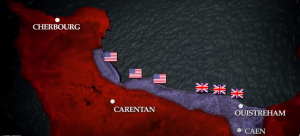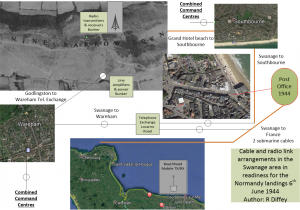Swanage and the 1944 Invasion of France
In late 1941, the General Post Office commenced discussions with the military authorities concerning communications with the proposed British invasion forces and Swanage was chosen to host two submarine cables as communication links to the D-Day invasion beaches, located in the Cherbourg area. A factor for choosing Swanage was its 150Km proximity to Cherbourg.
Swanage and the 1944 Invasion of France
In 1944, there were over 2 million troops from 12 different countries awaiting the invasion, they were primarily British, Americans, Canadians and Australians. On the 6 June, the invasion fleet of 1,200-plane airborne assault preceded an amphibious assault involving more than 5,000 vessels and 6 divisions, nearly 160,000 troops, crossed the English Channel and landed at the 6 Beachheads.
Once the beachheads had been taken the high frequency radio link was initiated from the bunker at the bottom of Godlingston Hill. Here the two diesel engines were started and synchronised to their alternators, the wooden infrastructure connected to a hinged base of the Arial mast, was pulled from the horizontal camouflage position to an operational vertical position and the power was applied to the aerial feed amplifiers. On D-day plus one the beachhead radio communications link was operational.
At this time the submarine cables were two miles of the shore of Querqueville near Cherbourg 100 km from the invasion beaches.
Three weeks later the cable ship “Monarch” picked up the unconnected submarine cables, under a barrage of American friendly fire and personnel connected the submarine cable to landline cables laid by troops.
The three week delay was down to the strategy of General Omar Bradley’s, one of the most capable American commanders of the war. Bradley believed that before Cherbourg, at the northern end of the Cotentin Peninsula, could be taken it needed to be isolated, so that the Germans would not be able to bring reinforcements or supplies in to help the defenders. American forces had landed at the base of the Cotentin on Utah beach, proposed in early 1944, as an addition the invasion plan. Landing here was not ideal with four metres tides, the minimum, to the north of the three mile long beach. The Germans were aware of this tidal characteristic, consequently, they fortified the associated beach exit more. The American VII Corps and V Corps landed at 0620, luckily for them the German General commanding the defenders Panzer Tank Division, Von Rundstedt, had his order to move the Panzers up to the beaches rescinded by General Jodt, who preferred to pass this decision to Hitler who was unfortunately sound asleep in bed.
This beachhead was the most successful, in 15 hours they were able to get 23,250 men ashore and 1,742 vehicles, sustaining only 197 casualties 22
Normandy Telecommunications Link
The 1st Dorset and 1st Hampshire, part of the 50th Infantry Division, were one of the first troops to land in Normandy at 07:25 on Gold Beach. Followed by the British 3rd Infantry Division on Sword Beach, east of Omaha. They were followed by the Canadian 3rd infantry Division on Juno Beach at 07:35. At 08:00 all the troops were clear of the beaches; Sword Beach was the most restrictive. All of the troop landing beaches had aid from beach mine clearing machinery, the Funnies. These modified tanks made access through the obstacles safer, on Sword beach they had cleared seven exits from the beach by 09:30 on the invasion morning.
Later in the day, the Allies had created a beachhead, in some places up to seven miles inland, thanks to the arrival of 250 gliders carrying paratroopers from the 6th Airborne division. They stopped the German 21st Panzer Division taking a foothold between the Canadian Juno beach and the British Sword beach 3.
The modified tanks known as the Funnies were introduced into the invasion arsenal by the Royal Mechanical and Electrical Engineers (REME), they were designed by John Donovan of the Canadian Engineers. The modified tanks were based and developed from their experience of the unsuccessful Dieppe invasion on 19th August 1942, where the Royal Canadian Engineers were tasked with getting the tanks off the beach by manually destroying obstacles and building ramps and consequently a siting target for the Germans, resulting in high fatal casualties in the following regiments: The Royal Regiment of Canada 227; The Royal Hamilton Light Infantry (Wentworth Regiment) 197; Les Fusiliers Mont Royal 119; Corps of Royal Canadian Engineers 27; The Essex Scottish Regiment 121 and others. A total of 916 fatal casualties out of the invasion force of 4,963 troops 21
Arrival of the American Army
The American Army 26th Infantry Regiment – known as the “Blue Spaders”, part of the Big Red One division, arrived in Swanage on November 1943, providing a huge boost to the beleaguered moral of the local population. They had food in abundance which they willing shared with the town’s population and the town viewed them as their saviours from the possibility of Nazi tyranny. It made people more positive and less tense they thought we have this rich and powerful friend and cannot lose the war!
The troops wore battle dress most of the day during training and when off-duty a walking out uniform made of a softer cloth, with olive green tunics, collar and tie, fawn trousers, neat shoes and a mass of brass buttons. Their equipment, for example ammunition and guns, arrived in wooden boxes made of 13 cm thick wooden sections. After they were no longer needed and dis-guarded, the locals reused them as garden sheds. When they left, the Swanage population fed on dis-guarded tinned meat for weeks.
When D-Day occurred on the 6th June 1944, at Worth Matravers it was possible to see the red glow emanating from their destination on the southern horizon.
From the 1st Division D-Day journal25
It was at 19:30 or H Plus 12 hours that the 26th Regiment, a reserve regiment, disembarked onto Omaha Fox Green beach.
Due to overhead cloud and gun fire the first opportunity the reserve regiment had to view the beach was at 15:00 hours, it was littered with vehicles and equipment and enemy fire falling the length and depth of the beach. To top this formidable array of defensive beach artillery was the Maisy Battery, positioned on a 100 foot cliff on the western edge of Omaha beach, this had 155 mm guns.


